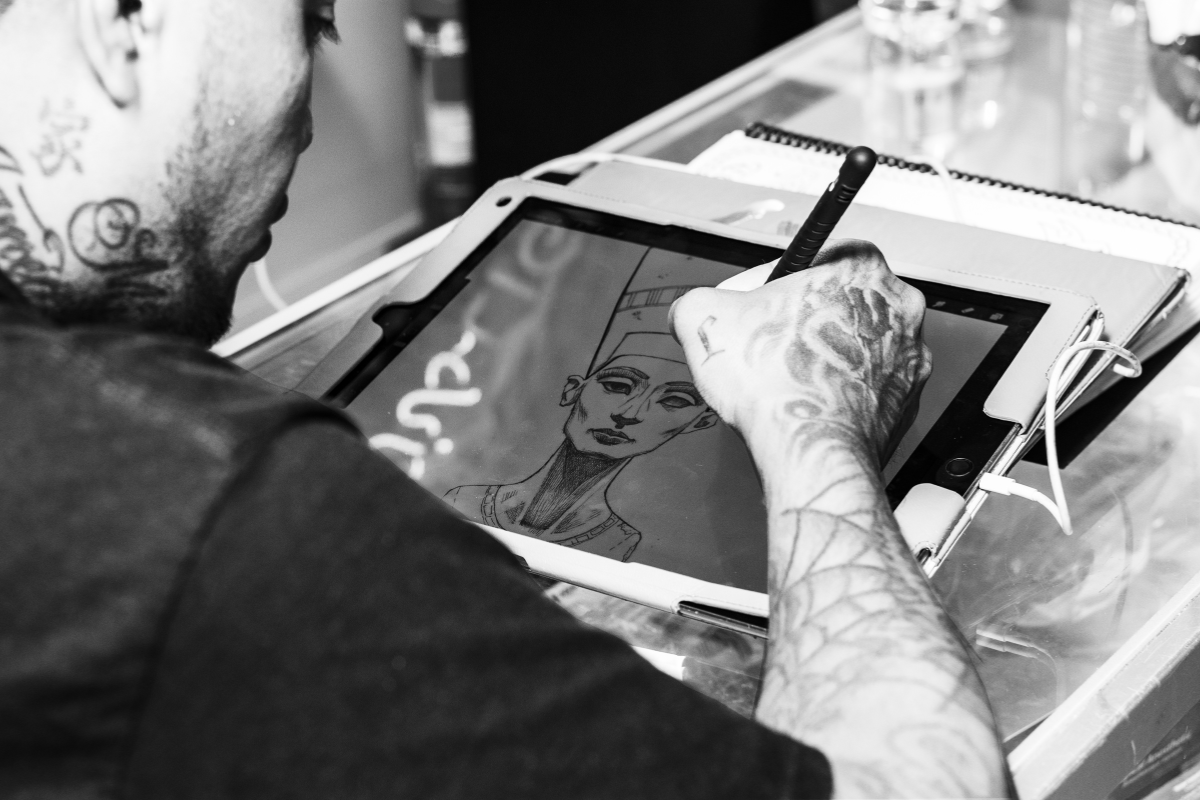What is Portrait Drawing?
The art of drawing faces is a captivating journey into the realm of human expression and emotion.
Each face tells a unique story, and capturing this on paper or digitally is a profound experience.
The challenge lies in not just replicating features accurately but in conveying the personality and essence of the individual.
Whether you’re sketching a loved one, a character from your imagination, or a stranger in a café, the process of bringing their facial features to life is both intricate and immensely satisfying.
This art form allows you to explore the depths of human expression, from the subtlest smirk to the most profound gaze, making it a deeply personal and rewarding endeavor.
Table of Contents
ToggleEssential Tools For Drawing Portraits
Traditional Tools
The choice of pencils in traditional drawing plays a pivotal role in the outcome of your artwork.
Each pencil grade, from the hard H to the soft B series, offers a different stroke quality and depth. For subtle shading and blending, consider using blending stumps or tortillas.
These tools help in creating smooth transitions and realistic textures, which are essential for bringing a portrait to life.
Don’t forget a good quality eraser, which is just as important as your pencils. It helps not only in correcting mistakes but also in creating highlights and refining details.

Digital Tools
Transitioning to digital art opens up a world of possibilities. Your tablet and stylus are the gateways to this realm.
The pressure sensitivity of the stylus allows for a range of line weights and textures, closely mimicking the feel of traditional drawing.
Familiarize yourself with the various brush settings available in your software – from pencil-like strokes to airbrush effects.
These tools can elevate your digital portraits. Experiment with layers, an invaluable feature of digital art, allowing you to work on different aspects of your portrait without affecting the underlying work.
Paper and Screen
In traditional art, the choice of paper can significantly affect your drawing. Textured paper is excellent for a more tactile feel and helps in achieving a range of shading effects.
Smooth paper, on the other hand, is ideal for fine details. In digital art, the tablet screen plays a similar role.
The resolution and sensitivity of your screen are crucial for the accuracy and detail of your work. Some artists prefer matte screen protectors to mimic the feel of paper, providing a more natural drawing experience.
By understanding and utilizing these essential tools, both traditional and digital artists can explore the fascinating world of portrait drawing with greater confidence and skill.
Whether you’re a seasoned artist or a beginner, the journey of capturing human faces is endlessly rewarding, offering new insights and challenges with every portrait you create.

How To Do Facial Proportions
The Rule of Thirds in Facial Features: The rule of thirds is a fundamental principle in art that helps in achieving balance and proportion.
Imagine dividing the face into three horizontal sections – from the forehead to the eyebrows, from the eyebrows to the bottom of the nose, and from there to the chin. This guideline helps in placing facial features accurately.
Aligning Eyes, Nose, and Mouth Correctly: The eyes are typically set halfway down the head, the nose at the next third, and the mouth a bit above the last third.
Remember, the space between the two eyes is approximately the width of another eye.
Step-by-Step Facial Features
Drawing Eyes
Expressions and Details: Eyes are the windows to the soul. Start with an oval shape, add the iris and pupil, and don’t forget the eyelids and eyelashes.
Pay attention to the light reflections in the eyes to bring them to life.

Sketching Noses
Shapes and Shadows: Noses can be tricky due to their varied shapes and the subtle shadows they cast.
Observe different noses and practice drawing them from various angles. Remember, the key to a realistic nose is in the shading, not the outline.

Creating Lips
Contours and Textures: Lips are all about contours and textures. Start with a simple line for the mouth, define the upper and lower lip, and then add light shading for depth. Notice how the light hits the lips and creates highlights and shadows.

Bringing Faces To Life
Techniques for Realistic Skin Textures: Skin texture can be suggested with fine, light pencil strokes and subtle shading.
Pay attention to the direction of the light source and how it affects the skin. Use a blending stump for smooth transitions.
Capturing Expressions and Emotions: The magic of portrait drawing lies in capturing expressions.
Practice drawing different facial expressions by changing the position of the eyebrows, the curve of the mouth, and the openness of the eyes.
Practice Exercises
Drawing Faces from Different Angles: Practice drawing faces from various angles – front, side, three-quarter view.
This will help you understand the structure of the face better and how different features look from different perspectives.
Experimenting with Diverse Facial Features: Don’t just stick to one type of face. Experiment with different ages, ethnicities, and facial structures. This diversity will enrich your skill and versatility as an artist.
Conclusion and Motivation
Tips For Continuous Practice
Mastery of drawing faces, like any skill, blossoms with consistent practice. Carve out a little time each day for sketching, even if it’s just a brief session.
This daily commitment can be as simple as a few minutes of doodling. Always have your sketchbook within reach for those spur-of-the-moment inspirations.
It’s these small, regular efforts that cumulatively refine your skills and deepen your understanding of facial nuances.
Encouragement To Develop A Unique Style
As your journey in portrait drawing progresses, you’ll naturally start to carve out a unique style. This is your artistic identity, the personal flair that distinguishes your work. Embrace this evolution.
Your individual approach, much like the distinct character of a nic-free bar, is what makes your art uniquely yours.
Remember, the path to drawing lifelike faces is one of observation, practice, and discovery. If you ever find yourself in a creative rut, it’s okay to take a step back.
Sometimes, a brief pause or a moment of relaxation, like enjoying a nic-free bar, can refresh your perspective.
Persist in your daily practice, and you’ll see how each sketch brings you closer to capturing not just the appearance but the very essence of your subjects.
Keep exploring, keep practicing, and let your unique style shine through in every portrait you create.











